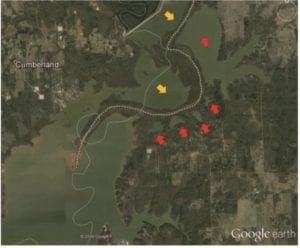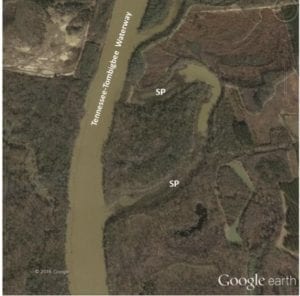Chapter 9 : Lateral Connectivity
9.1 Introduction
9.2 Maintenance of Lateral Connectivity
9.2.1 Submersed Check Dams
9.2.2 Connection Channels
9.2.3 Water-Level Manipulations
9.2.4 Levee Setbacks
9.2.5 Closure Structures
9.2.6 Notched Dikes
9.2.7 Culverts
9.3 Maintenance of Adjoining Habitat 9.3.1 Weirs
9.3.2 Pump Systems
9.3.3 Excavated Pools
Introduction
The extent of backwaters adjacent to reservoirs varies and controls their influence on reservoir fish assemblages. Backwaters may include wetlands, sloughs, and oxbow lakes within the floodplain adjacent to the reservoir and may be inundated or connected periodically and temporarily by the reservoir. Reservoirs have been constructed for many purposes, including flood control, navigation, water supply, hydropower, and recreation (Kennedy 1999), and differ in the extent of backwater availability based on where they were built and how they are operated. For example, reservoirs positioned lower in a basin, such as flood control and navigation reservoirs, tend to have more extensive floodplains than do deeper hydropower reservoirs that are generally located higher in a basin where backwaters tend to be more limited. Thus, lateral connectivity tends to be more relevant in lowland reservoirs.
The rehabilitation of large rivers and reconnection of isolated floodplains and their associated habitats has become a critical component of river ecosystem restoration (Galat et al. 1998; Holmes and Nielsen 1998; Sear et al. 1998; Buijse et al. 2002; Florsheim and Mount 2002). Techniques used to reconnect river–floodplain systems are at the early stages of development and have for the most part received limited or no attention in reservoirs. Reservoir backwaters are often ignored because they are considered to be drastically transformed by the effects of impoundment. To various extents backwaters have been permanently submerged by the reservoir, but in many river systems, particularly lowland rivers, abundant backwaters remain principally in the upper end of reservoirs (Oliveira et al. 2005; Buckmeier et al. 2014; Miranda et al. 2014). These backwaters, if accessible, can benefit reservoir fishes and riverine fishes that use the reservoir seasonally.
Lateral connectivity has been suggested as a major determinant of species richness and species composition for many taxonomic groups (Tockner et al. 1999). Influenced by flood-pulsing of the river and by artificial flood pulses imposed by the man- agement of water levels in the reservoir, floodplains, sloughs, backwaters, wetlands, and tributaries contiguous to reservoirs can provide essential habitat for lacustrine and riverine fishes. These water bodies are used by many reservoir species for spawning and nursery sites, by permanent residents, and by species that live in the reservoir or tributaries seasonally or during specific life stages. Connectivity also benefits riverine species that depend on floodplains and backwaters to complete life cycle processes (Miranda et al. 2014).

Connectivity between a river and its floodplain is a time-dependent occurrence linked to the hydrological dynamics of the river (Tockner et al. 1999). The occurrence of a river–backwater connection depends on prevailing hydrologic conditions within the river and the surface elevation of the floodplain. As river stage exceeds floodplain elevation thresholds on the ascending limb of the hydrograph, a connection occurs and floodplains and backwaters are inundated. There is a large body of literature about the interaction between rivers and floodplains (reviewed by Ickes et al. 2005), but there is a scarcity of data about the interaction between reservoirs and floodplains. For reservoirs, lateral connectivity is dependent on the water level in the reservoir and on adjacent topography. Dams may have strict temporal release schedules dictated by the operational goals of the reservoir. Such artificial hydrographs tend to make connection to backwaters more disciplined and possibly temporally inharmonious with the movement, reproduction, feeding, and refuge needs of floodplain species.
Sedimentation can cause contiguous water bodies to become physically separated from the reservoir. The hydrodynamics of many reservoirs require storage of water high in suspended sediment that generally settles near the mouth of tributaries as water enters the reservoir (section 3) or in pockets with reduced flows anywhere in the reservoir. Coincidentally, in many reservoirs, backwaters occur near the entrance of tributaries. Over time (often a few years or decades) tributaries and associated backwaters become isolated from the reservoir (Figure 9.1) except during peak flows (Patton and Lyday 2008). Similarly, pockets of water next to channels trap sediment and develop sediment plugs near their entrance, eventually becoming seasonally or permanently isolated from the reservoir (Figure 9.2; Slipke et al. 2005). These areas may become inaccessible to seasonal fish use, trap adult and juvenile fish requiring access to the reservoir or tributaries, prevent utilization by anglers or other users, or even go dry from lack of connectivity to surface or ground water.

Loss of connectivity also develops in shallow embayments and major tributaries through the fragmentation created by the combination of sediment deposition and accretion. As these areas of the reservoir become filled with sediment, water that flows into the reservoir helps to form channels by depositing sediment on both sides of the flow channel. Although this process is occurring within the reservoir basin, it is similar to the formation of a natural river levee. As discharges exceed the banks, water spills out of the channel, losing much of its energy and allowing sediment to fall out of the water column and deposit adjacent to the channel. Over time, this process tends to separate the channel from the backwaters and isolate backwaters from each other. The resulting landscape resembles a series of reservoir fragments bisected by a riverine channel (Figure 9.1; Patton and Lyday 2008). It is not clear what short and long-term effects this isolation has on fish assemblage composition. Nevertheless, it is likely to affect fisheries negatively by reducing access to floodplain fishing sites.
Connectivity to backwaters may also be reduced by the effects of upstream dams. Chains of dams reduce flow variability and thus attenuate floods that otherwise would have inundated side channels and floodplains to connect isolated backwaters. Reduced floods in floodplains in the upper reaches of reservoirs may no longer flush fine sediment that can accumulate and may exacerbate loss of connectivity to backwaters.
Back to the Top
9.2 Maintenance of Lateral Connectivity
Connectivity between floodplain aquatic habitats and the main reservoir can be maintained, restored, or created through several procedures (Roni et al. 2005). Submersed check dams, connecting channels, water-level manipulation, and levee set- backs can restore connectivity to existing backwaters. Closure structures can reduce back-flooding and sedimentation and thus avert loss of connectivity. The use of notched dikes and culverts may also provide opportunity for creating additional connectivity.
Back to the Top
9.2.1 Submersed Check Dams
Become a Contributing Sponsor
Become a part of projects that need your support.

